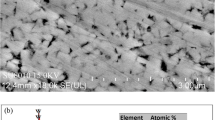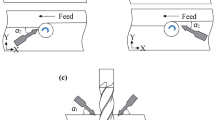Abstract
This paper discusses the utilization of the minimum quantity lubrication (MQL) method in end milling using a coated carbide tool for stainless steel and titanium alloy workpieces. The effects of MQL were mainly evaluated by tool flank temperature, cutting force, tool wear behavior, and surface roughness. In MQL cutting of stainless steel and titanium alloy at cutting speed v = 25 m/min, the tool flank temperature decreased by approximately 50 and 100 °C, respectively, in comparison with dry cutting. The effect of MQL on tool flank temperature was especially pronounced at low-cutting speeds. Conversely, the tool flank temperature in MQL cutting of titanium alloy was higher than that of dry cutting at v = 100 m/min or more. In high-speed cutting of titanium alloy, it was observed that several chips had adhered to the cutting edge of the rake face, which reached a high temperature due to the heat generated by cutting. In the cutting of titanium alloy, the tool flank temperature at both a higher feed rate and depth of cut was lower than that in high-speed cutting under conditions where the cutting efficiency was the same. Peeling of the coating film covering the tool in dry and air-blow cutting of stainless steel and titanium alloy was more pronounced than that in MQL cutting. The surface roughness was greatly improved by supplying an oil mist in low-speed cutting of stainless steel.
Similar content being viewed by others
References
Tang L, Huang J, Xie L (2011) Finite element modeling and simulation in dry hard orthogonal cutting AISI D2 tool steel with CBN cutting tool. Int J Adv Manuf Technol 53:1167–1181. doi:10.1007/s00170-010-2901-2
Ezugwu EO, Wang ZM (1997) Titanium alloys and their machinability—a review. J Mater Process Technol 68:262–274. doi:10.1016/s0924-0136(96)00030-1
Diniz EA, Micaroni R (2002) Cutting conditions for finish turning process aiming: the use of dry cutting. Int J Mach Tools Manuf 42:899–904. doi:10.1016/s0890-6955(02)00028-7
Rivero A, Aramendi G, Harranz S, López de Lacallc LN (2005) An experimental investigation of the effect of coatings and cutting parameters on the dry drilling performance of aluminium alloys. Int J Adv Manuf Technol 25:1–11. doi:10.1007/s00170-004-2349-3
Kim SW, Lee DW, Kang MC, Kim JS (2001) Evaluation of machinability by cutting environments in high-speed milling of difficult-to-cut materials. J Mater Process Technol 111:256–260. doi:10.1016/s0924-0136(01)00529-5
Jianxin D, Tongkun C, Xuefeng Y, Jianhua L (2006) Self-lubrication of sintered ceramic tools with CaF2 additions in dry cutting. Int J Mach Tools Manuf 46:957–963. doi:10.1016/j.ijmachtools.2005.07.047
Ze W, Jianxin D, Yang C, Youqiang X, Jun Z (2012) Performance of the self-lubricating textured tools in dry cutting of Ti-6Al-4V. Int J Adv Manuf Technol 62:943–951. doi:10.1007/s00170-011-3853-x
Li K-M, Liang SY (2007) Modeling of cutting forces in near dry machining under tool wear effect. Int J Mach Tools Manuf 47:1292–1301. doi:10.1016/j.ijmachtools.2006.08.017
Rahim EA, Sasahara H (2011) A study of the effect of palm oil as MQL lubricant on high speed drilling of titanium alloys. Tribol Int 44:309–317. doi:10.1016/j.triboint.2010.10.032
Braghini JA, Diniz AE, Filho FT (2009) Tool wear and tool life in end milling of 15-5 PH stainless steel under different cooling and lubrication conditions. Int J Adv Manuf Technol 43:756–764. doi:10.1007/s00170-008-1744-6
Thepsonthi T, Hamdi M, Mitsui K (2009) Investigation into minimal-cutting-fluid application in high-speed milling of hardened steel using carbide mills. Int J Mach Tools Manuf 49:156–162. doi:10.1016/j.ijmachtools.2008.09.007
Venkatesh VC, Zhou DQ, Xue W, Quinto DT (1993) A study of chip surface characteristics during the machining of steel. CIRP Ann 42:631–636. doi:10.1016/S0007-8506(07)62526-8
Sugita N, Osa T, Mitsuishi M (2009) Analysis and estimation of cutting-temperature distribution during end milling in relation to orthopedic surgery. Med Eng Phys 31:101–107. doi:10.1016/j.medengphy.2008.05.001
Li A, Zhao J, Luo H, Pei Z, Wang Z (2012) Progressive tool failure in high-speed dry milling of Ti-6Al-4V alloy with coated carbide tools. Int J Adv Manuf Technol 58:465–478. doi:10.1007/s00170-011-3408-1
Okada M, Hosokawa A, Tanaka R, Ueda T (2011) Cutting performance of PVD-coated carbide and CBN tools in hardmilling. Int J Mach Tools Manuf 51:127–132. doi:10.1016/j.ijmachtools.2010.10.007
Hosokawa A, Ueda T, Onishi R, Tanaka R, Furumoto T (2010) Turning of difficult-to-machine materials with actively driven rotary tool. CIRP Ann 59:89–92. doi:10.1016/j.cirp.2010.03.053
Furumoto T, Ueda T, Kasai A, Hosokawa A (2011) Surface temperature during cavity preparation on human tooth by Er:YAG laser irradiation. CIRP Ann 60:555–558. doi:10.1016/j.cirp.2011.03.065
Okada M, Ueda T, Hosokawa A, M’Saoubi R, Muranaka T, (2010) Cutting characteristics of indexable insert drill. Proc 4th CIRP Int Conf High Perform Cut 24-26 October, Gifu, Japan: 333-336
Hoyt S. L. (1954) ASME Handbook, Metals Properties. McGRAW-HILL BOOK 58: 162-163
Jin LZ, Sandström R (1994) Machinability data applied to materials selection. Mater Des 15:339–346. doi:10.1016/0261-3069(94)90028-0
Ueda T, Hosokawa A, Oda K, Yamada K (2001) Temperature on flank face of cutting tool in high speed milling. CIRP Ann 50:37–40. doi:10.1016/S0007-8506(07)62065-4
Author information
Authors and Affiliations
Corresponding author
Rights and permissions
About this article
Cite this article
Okada, M., Hosokawa, A., Asakawa, N. et al. End milling of stainless steel and titanium alloy in an oil mist environment. Int J Adv Manuf Technol 74, 1255–1266 (2014). https://doi.org/10.1007/s00170-014-6060-8
Received:
Accepted:
Published:
Issue Date:
DOI: https://doi.org/10.1007/s00170-014-6060-8




